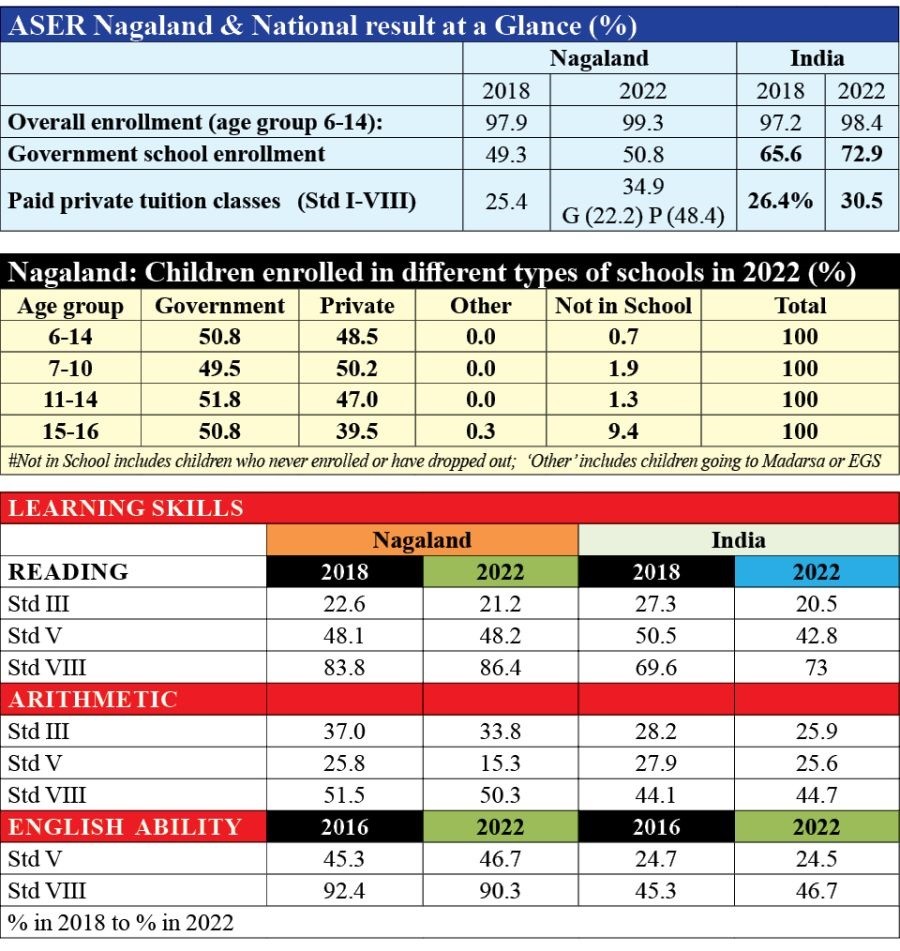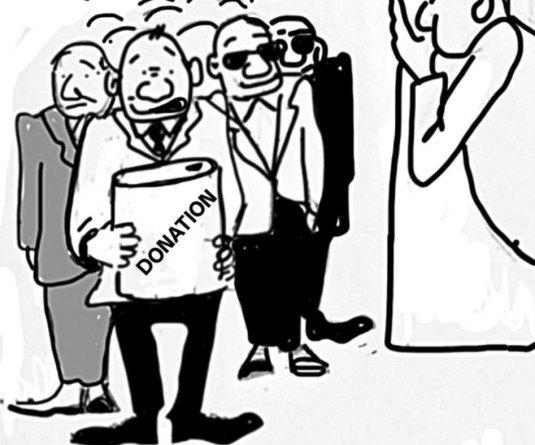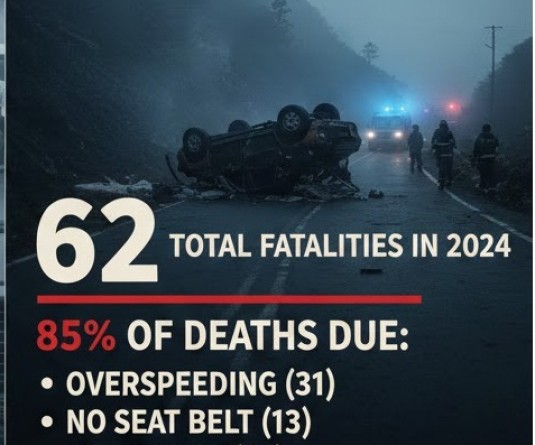
• Overall & Govt school enrollment improves
• Decrease in Arithmetic, English reading abilities
• Huge spike in paid private tuition classes
Morung Express News
Dimapur | January 19
Almost 1 in 10 of Nagaland’s children in the age group of 14-16 years are not attending schools in rural areas, informed the latest Annual Status of Education Report (ASER) 2022.
While 'Not in school' is designated as ‘children who never enrolled or have dropped out,’ age-wise data from 6-16 years suggest that it is mostly dropouts in the case of Nagaland. As per the report released in New Delhi on January 19, 9.4% of children in the 15-16 year age group were ‘not in school’.
Percentage of out of school children from 6-14 years was just 0.7%, indicating that most are dropping out in the intervening period. The proportion of children in the age group not currently enrolled across India was 1.6%.
Such data is similar to results reflected in the Unified District Information System for Education Plus (UDISE+) report which show high dropout rate in the Secondary (Class 9-10) level.
The dropout level in the secondary level as per the UDISE 2021-22 report was 17.5%, a huge spike from 4% in Upper Primary level (Class 6-8).
Both the reports suggest how the Right to Education Act 2009, with provision for free and compulsory education to all children of the age of six to fourteen years, is crucial in ensuring quantitative as well as qualitative education as primacy of government intervention in education.
After a gap of 4 years after prolonged closures due to the COVID-19 pandemic, ASER 2022 returned to the field nationwide and reached 616 rural districts across the country, stated a press release from Pratham Education Foundation, which conducted the survey.
The household survey recorded the schooling status of children in the 3-16 age group and assessed children aged 5-16 in basic reading, arithmetic, and English ability.
In Nagaland, data was collected from 9 out of the 11 districts.
Overall enrollment
Meanwhile, ASER 2022 revealed that the overall enrollment (age group 6-14) continues to remain high in Nagaland, increasing from 97.9% in 2018 to 99.3% in 2022. This was above the national average of 98.4%.
Out of the total enrollment in the 6-14 years age group, 50.8% were in Government schools while 48.5% were in private schools. The enrollment in government schools was a slight improvement over 2018 when the figure stood at 49.3%.
Nationally, enrollment in government schools increased from 65.6% in 2018 to 72.9% in 2022.
Almost 50% students in private schools take tuitions
Over the past decade, the survey revealed steady increases in the proportion of children in Standards I-VIII taking paid private tuition classes.
In Nagaland, it increased from 25.4% in 2018 to 34.5% in 2022, propelled by huge percentage of students in private schools availing such classes. Accordingly, paid tuitions by students in private schools stood at 48.4% against 22.2% in government schools.
The All-India figure for private tuition classes was 30.5%. Comparative data provided in the survey informed that percentage of children in Standards I-VIII who take paid tuition classes increased from 16.8% in 2010 to 34.9% in 2022.
Learning levels
Meanwhile, nationally, children’s basic reading ability has dropped to pre-2012 levels, reversing the slow improvement achieved in the intervening years, the report noted.
In Standard III, percentage of children in government and private schools in Nagaland who can read Standard II level witnessed slight decline from 22.6% in 2018 to 21.2% in 2022. Nationally, it dropped from 27.3% in 2018 to 20.5% in 2022.
Further, the proportion of children in Standard V who can at least read a Standard II level text has been more or less constant from 48.1% in 2018 to 48.2 % in 2022; while across India, it fell from 50.5% to 42.8% during the corresponding period.
Reading level of Standard VIII students in Nagaland, however, increased from 83.8% in 2018 to 86.4% in 2022. It was above the national level of 69.6%.
Children’s basic arithmetic levels in 2022 also declined over 2018 levels for most grades.
In Standard III, the figure of children who could do at least subtraction dropped from 37% in 2018 to 33.8 % in 2022, while it decreased from 28.2% in 2018 to 25.9% in 2022 nationally. ‘
The proportion of children in Standard V across India who can do division also fell slightly, from 27.9% in 2018 to 25.6% in 2022 but witnessed a large drop in Nagaland from 25.8% in 2018 to 15.3% in 2022.
In Standard VIII, the proportion of children who can do division increased from 44.1% in 2018 to 44.7% in 2022 nationally. However, in Nagaland, it decreased from 51.5 % in 2018 to 50.3% in 2022.’
According to the report, children’s ability to read simple English sentences has stayed more or less at the 2016 level for children in Standard V (from 24.7% in 2016 to 24.5% in 2022).
However, in Nagaland, English reading and comprehension for children of standard V dropped from 65% in 2016 to 57.9% in 2022.
Likewise, there was also a drop in the reading and comprehension level of Standard VIII students from 92.4% in 2016 to 90.3% in 2022.
In 2022, 55.6% of children in Standard III could read words but not sentences. Out of this, 60.6% could tell the meaning of the words. Nationally, it was 55.3%.






